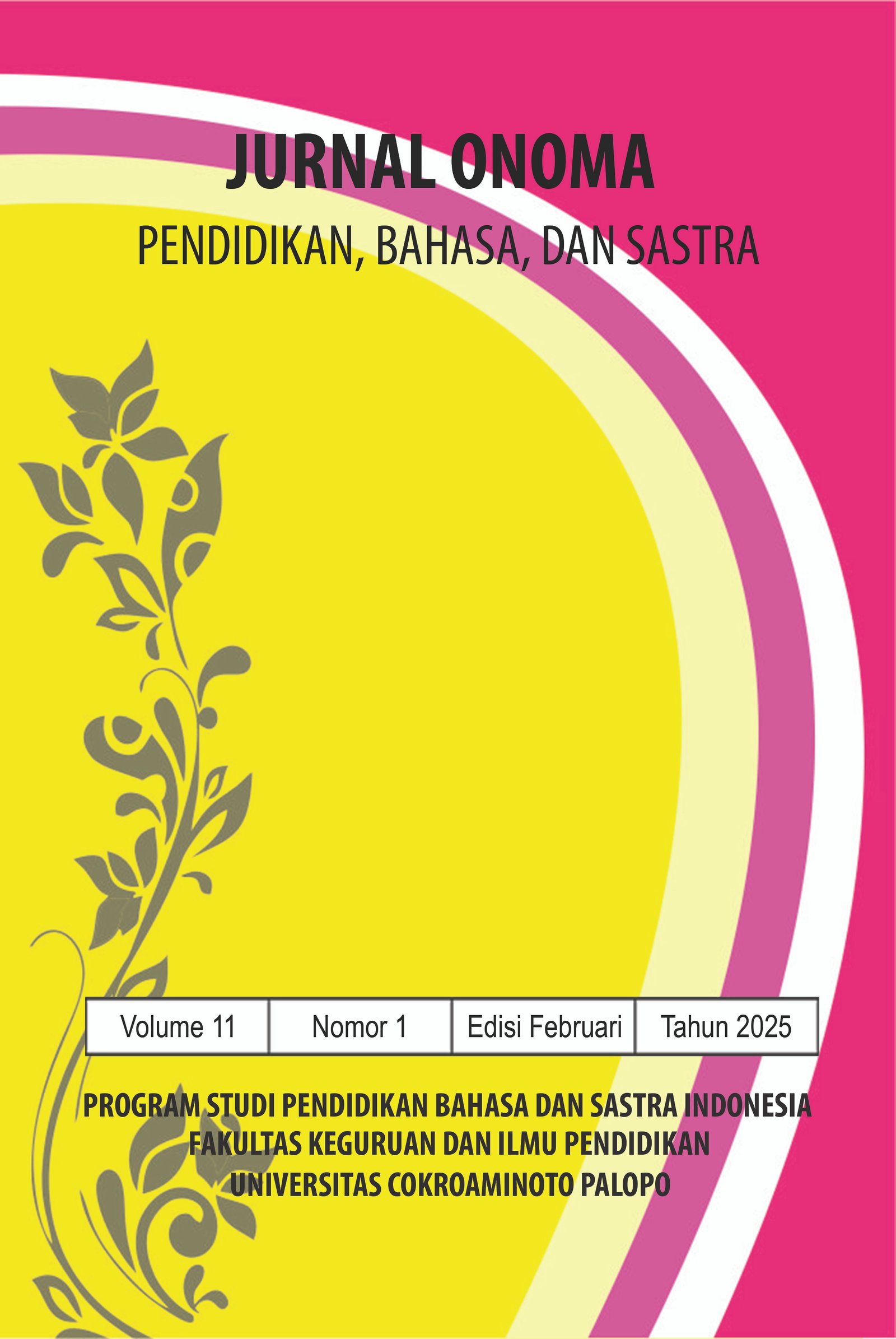Penerapan Metode Pengajaran Silent Way (Cara Senyap) pada Pembelajaran Puisi melalui Model Project Based Learning di SMK Tunas Harapan Pati
https://doi.org/10.30605/onoma.v11i1.5376
Keywords:
silent way, project -Based LearningAbstract
Penelitian ini bertujuan untuk mengetahui langkah-langkah dalam penerapan metode silent way (cara senyap) dengan model pembelajaran yang berbasis proyek di sekolah. Penelitian ini menggunakan metode kualitatif dengan metode analisis deskriptif. Sumber data dalam penelitian ini berupa sumber data sekunder, yakni berasal dari sebuah video praktik mengajar dari seorang guru yang sedang mengikuti kuliah profesi atau PPG. Hasil penelitian ini ditemukan dua bentuk ujaran terkait dengan penggunaan alat bantu visual, dua ujaran mengenai interaksi minimal dari guru, dua ujaran mengenai siswa berperan aktif, lalu dua ujaran terkait dengan keterampilan berbicara dan mendengarkan, kemudian dua ujaran terkait dengan pembelajaran berdasarkan konteks, serta dua ujaran mengenai evaluasi berkelanjutan. Serta terdapat enam tahap pelaksanaan model pembelajaran project-based learning (PjBL) dalam pembelajaran yaitu: : (1) penentuan pertanyaan dasar atau project, (2) perencanaan desain project, (3) penyusunan jadwa project, (4) penyelasaian project dengan monitoring, (5) pengujian hasil project, (6) evaluasi. Pada penerapan model pembelajaran project-based learning (PjBL) telah ditemukan sebanyak 11 data dari masing-masing tahapan pembelajaran.
Downloads
References
Angga, S., et al. (2017). Judul Artikel. Jurnal PQR.
Arikunto, S. (2009). Penelitian Pendidikan: Suatu Pendekatan Praktik. Rineka Cipta.
Dewi, S. (2017). Pendidikan Sastra dan Peningkatan Kemampuan Berpikir Kritis Siswa. Jurnal Pendidikan Sastra Indonesia, 9(2), 75-82.
Dewi, S. (2019). Pendekatan Multidimensional dalam Pembelajaran Puisi. Jurnal Pendidikan Seni, 14(3), 210-217.
Gattegno, C. (1972). The Silent Way. Educational Solutions.
Gattegno, C. (1972). The Silent Way: A New Approach to Language Teaching. Educational Solutions.
Indrawati, S. (2020). Pengaruh Pembelajaran Berbasis Proyek terhadap Kreativitas Menulis Puisi. Jurnal Pendidikan Bahasa dan Sastra Indonesia, 15(1), 134-142.
Miller, L., & Davis, M. (2018). Building Self-confidence in Autonomous Learning. Journal of Education Psychology, 25(1), 102-110.
Prasetyo, D. (2017). Minat Siswa SMK terhadap Pembelajaran Puisi. Jurnal Pendidikan dan Sastra Indonesia, 9(3), 112-118.
Richards, J.C., & Rodgers, T.S. (2014). Approaches and Methods in Language Teaching (3rd ed.). Cambridge University Press. DOI: https://doi.org/10.1017/9781009024532
Santosa, I. (2016). Puisi dan Estetika dalam Pendidikan. Jurnal Pendidikan dan Sastra, 14(2), 145-154.
Santoso, I. (2016). Tantangan Pembelajaran Puisi di Sekolah Menengah Kejuruan. Jurnal Pendidikan Bahasa dan Sastra, 12(2), 45-53. DOI: https://doi.org/10.17509/bs_jpbsp.v12i1.3609
Shumin, K. (2002). The Silent Way: A Communicative Approach to Language Teaching. The Modern Language Journal, 86(1), 90-95.
Sugimoto, H. (2019). Silent Way as a Pathway to Autonomous Learning. Journal of Language Education and Development, 30(2), 123-134.
Sugiono, M. (2017). Metode Penelitian Kuantitatif, Kualitatif, dan R&D. Alfabeta.
Thomas, J. W. (2000). A Review of Research on Project-Based Learning. The Autodesk Foundation.
uhardi, A. (2021). Pendekatan Interdisipliner dalam Pembelajaran Puisi. Jurnal Pendidikan Seni dan Sastra, 16(2), 130-138.
Wijaya, I., et al. (2018). Judul Artikel. Jurnal ABC.
Yuliana, L. (2018). Tantangan Emosional dalam Pembelajaran Puisi. Jurnal Pendidikan Bahasa dan Sastra, 15(1), 56-64.
Yuliana, L. (2019). Puisi dan Pengalaman Estetika dalam Pembelajaran. Jurnal Pendidikan Bahasa dan Sastra, 14(3), 134-142.
Downloads
Published
How to Cite
License
In submitting the manuscript to the journal, the authors certify that:
- They are authorized by their co-authors to enter into these arrangements.
- The work described has not been formally published before, except in the form of an abstract or as part of a published lecture, review, thesis, or overlay journal.
- That it is not under consideration for publication elsewhere,
- That its publication has been approved by all the author(s) and by the responsible authorities – tacitly or explicitly – of the institutes where the work has been carried out.
- They secure the right to reproduce any material that has already been published or copyrighted elsewhere.
- They agree to the following license and copyright agreement.
License and Copyright Agreement
Authors who publish with Onoma Journal: Education, Languages??, and Literature agree to the following terms:
- Authors retain copyright and grant the journal right of first publication with the work simultaneously licensed under Creative Commons Attribution License (CC BY 4.0) that allows others to share the work with an acknowledgment of the work's authorship and initial publication in this journal.
- Authors are able to enter into separate, additional contractual arrangements for the non-exclusive distribution of the journal's published version of the work (e.g., post it to an institutional repository or publish it in a book), with an acknowledgment of its initial publication in this journal.
- Authors are permitted and encouraged to post their work online (e.g., in institutional repositories or on their website) prior to and during the submission process, as it can lead to productive exchanges, as well as earlier and greater citation of published work.

















